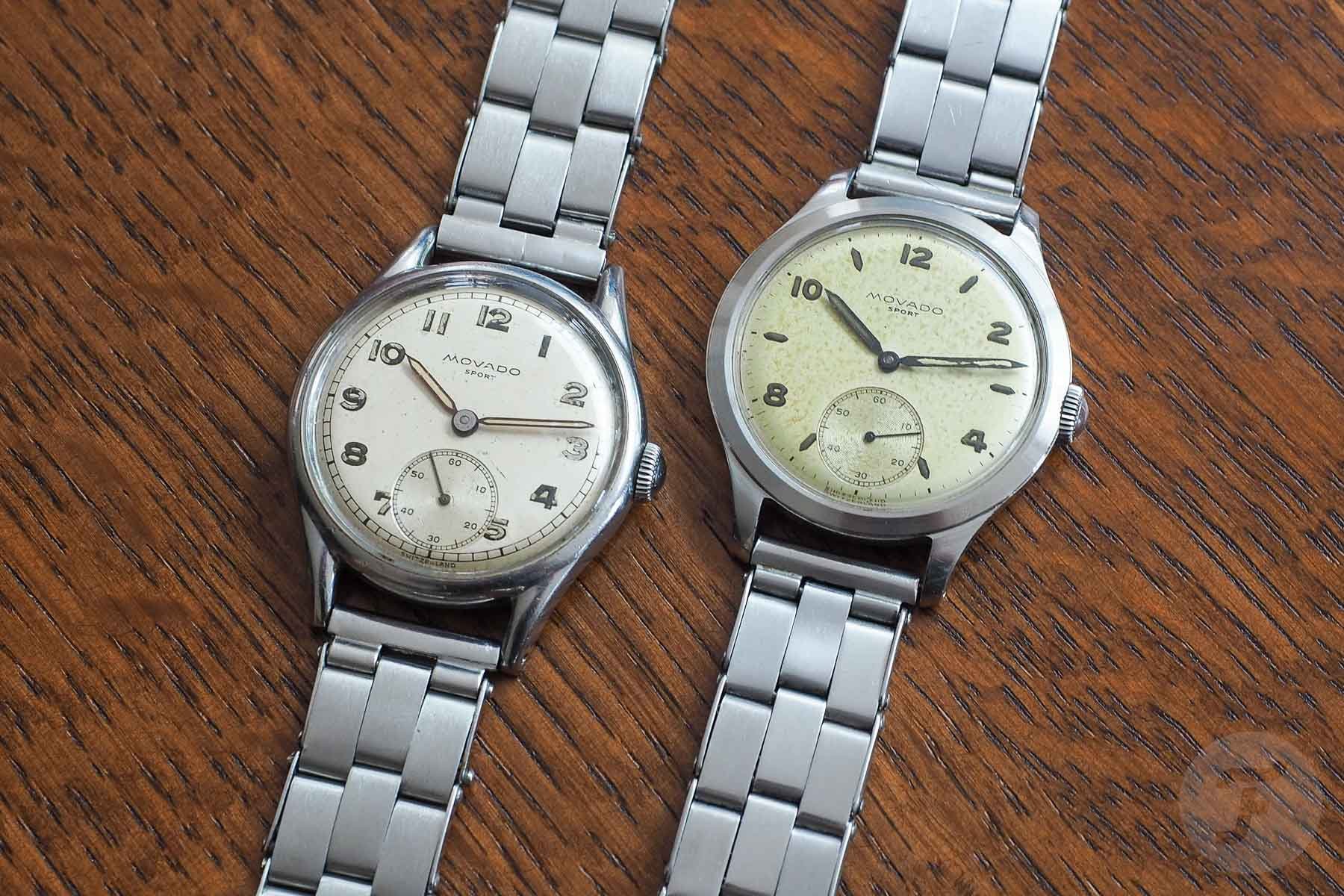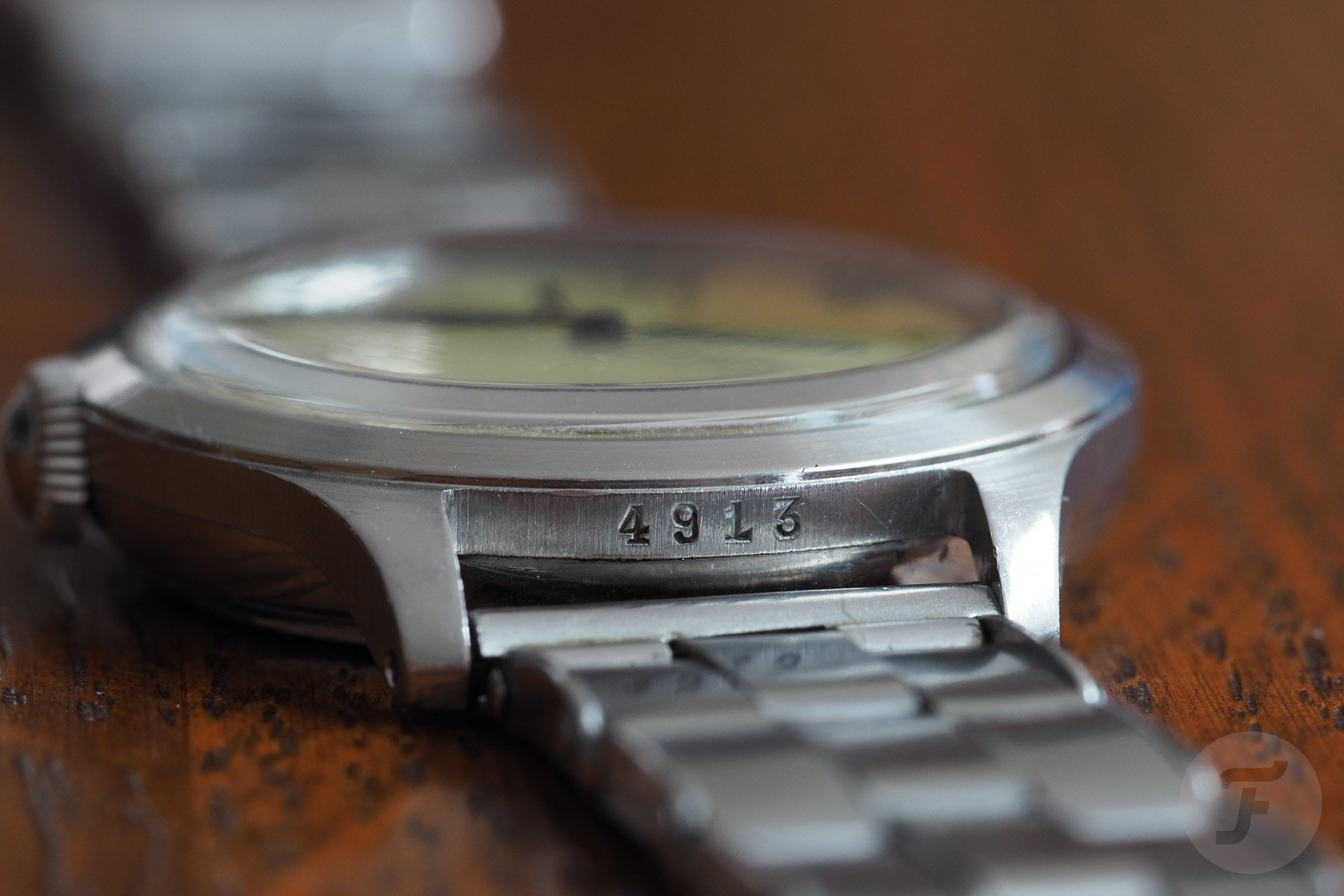I’ve handled a lot of watches over the last 30 years, but as far as I know, I had never owned a Borgel cased watch until last year. I currently own two Borgel watches that are worth sharing with you. Both are Movado Sport models from the ’50s, and are beautiful watches regardless of the case maker.
My interest in watches from the 1930s to 1950s continues to unearth great gems. While watches from subsequent decades are often associated with case, movement, and dial makers, case makers play a larger role in earlier watches. Why is that? I think there are a few reasons. Tariffs on precious metals made local market case makers more prevalent. Also, wristwatches were still in their infancy and many big name manufacturers were beginning to transition away from making pocket watch cases. Finally, innovation was underway with companies like François Borgel leading the charge in waterproofing as a rival to Rolex.
World War I era Vogel trench clock — Image: Vintage Gold Watches
François Vogel — A Brief History
For more on the history of François Vogel, check out this insightful article by A Collected Man, but I’ll give a quick summary. The company was founded in Switzerland in the late 1800s. In 1891, the company filed a patent for the first waterproof and dustproof pocket watch. Unlike today, where gaskets and threaded parts work in tandem, this invention used precision tolerances and a series of screwed case parts for protection. Military conflicts are often the test bed for such innovations, and Vogel supplied pocket and trench watch cases to many brands during World War I. Interestingly, the bezels on these watches, used to screw the parts into the watch case, look a lot like Rolex’s raised casebacks.

Borgel Mido with a decagonal case — Image: Cool Vintage Watches
Early waterproof cases
In the ’20s, Rolex introduced the Oyster case after using the Borgel case for some of their early models. Borgel, which was acquired by Taubert & Fils during this time, continued to innovate, releasing watches with decagonal cases soon after. These watches featured a similarly shaped case back that required a special tool to open and close. Mido was an early adopter of these cases, and although their cases tend to be smaller (under 30mm), they are sturdy and cool watches.

Patek Philippe Calatrava 565 in a Borger case — Image: Wind Vintage
The decagonal case back continued to be used for the next few decades, with many brands using the Borgel case on their watches. Most famously, Patek Philippe used it for their sublime Calatrava Reference 565 and chronograph Reference 1463. Doxa, West End Watch, and Movado were also a few brands that used this beautiful case. Some of their models are similar in design to Patek watches and now fetch high prices. Apart from the protected case back design, the Borgel case is characterized by a domed and raised crown. Also, the inside of the case back has the letters “BRIT PAT” or “FB” engraved on it, along with a small key. Durability was a top priority, but not the brand’s only focus. If you are buying one, expect a beautifully crafted case.

Movado Sport models with Borgel cases — 18127 (left) and 18136 (right)
Two Movado Sport models
Movado deserves to be recognized as one of the great watch brands of the first half of the 20th century. The company produced movements and many fascinating designs. Looking inside a 1950s Movado, you’ll see attractive in-house calibers, neat finishing, and premium touches like chaton-set gems. Movado also made extensive use of Borgel cases. The Movado Sport models in this article are from the same era and feature two different case styles.

Clues about the history of these watches
It’s worth mentioning that Movado’s history is not as thoroughly documented as many of us would like. The History of Movado by Fritz von Osterhausen is the main reference, but while useful, there are significant gaps in the information. That said, we’re used to receiving clear records from brands like Omega, Longines, and Patek Philippe. This archival service does not exist for Movado, which is a shame as there are countless great reference sources. Movado is supposed to have archives in their New Jersey offices, but these are not publicly available. Therefore, we have to work with what we have at hand.

These vintage Movado Borgel cases feature hidden hints of the watch’s originality, such as the four numbers engraved between the top lugs of the center case, and removing the case back reveals a dust cap over the movement for a premium look.

The reverse side of the caseback is engraved with two sets of numbers, Movado’s signature, a statement that it is Swiss made, and the Vogel logo. The top seven digits are the serial number, and the last four digits should match the numbers on the outside of the midcase. This means that the case and caseback were made “together,” a sign of confidence in the watch’s originality. The bottom five-digit code provides further information. The first digit, “1,” can be cross-referenced in the book and signifies a stainless steel case. The last four digits are checked against additional tables and fall within a range that matches watches that use the Movado Caliber 125, which we’ll explain later.

Analysis of the Borgel Affair
These two Borgel cased Movados are different shapes. Both are part of the 50’s Sport line and are a set of reliably waterproof and arguably affordable watches. Note that Movado also made a similar watch without this name. I don’t know how many variations of the case style there were, but I saw many during my research. Both watches are 34mm in diameter, have acrylic crystals, and use Borgel’s signature crown.


Quality Details
Cosmetically, the reference 18127 has a softer case design, a more prominent domed crystal (10mm thick), and a rounded integrated bezel. The 18136 is more Calatrava-like, with edgier lugs, an angled stepped bezel, and a flatter domed crystal (9mm thick). Both have 16mm lug spacing and drilled lug holes. From the side, the 18136 is particularly attractive with its rounded lugs and mix of vertical brushed and polished finishes.


The 18127 is by no means inferior, and the transition from the bezel to the inner lugs is beautifully executed. I can only apologize for the feel of these watches; I apologize for waiting so long to get my hands on some of these gems, because they are so beautiful in person. It may sound like an exaggeration, but these watches feel just as well made as their Rolex contemporaries; they’re sturdy, beautifully sculpted, and exude a premium feel.

Perfect dialing
Both Movados feature silver dials with radium luminous indices and hands. The 18127 has a selection of luminous Arabic numerals and matching hands. The raised seconds subdial has a black hand. It appears smaller due to the dial, softer case design, and thicker bezel. Moving on to the 18136, the dial design is slightly different. The hands are similar, but the dial is more open with an alternating pattern of numerals and batons. Look closely at all the indices and you’ll see a shadow effect created by the radium revealing some of the black ink underneath.

Uses caliber 125
The Movado Caliber 125 is a 15-jewel hand-wound movement that runs at 18,000 vibrations per hour. It is 28.4 mm in diameter and 3.95 mm thick, fitting snugly into the Borgel case. The finishing is simple but pretty. My experience with the movements in these two watches has been nothing but good. The calibers wind smoothly and keep accurate time, especially for their age. Movado makes quality movements, and this is another reminder of how different the company is today. The signature crown is a tactile object that adds to the enjoyment of these watches.

Wear these beautiful things
I change watches often, but this Borgel-cased Movado Sport model has seen a fair bit of use over the past month. Each one is sturdy enough to withstand everyday activities and gives just the right amount of satisfaction when I look down to check the time. I mentioned that these watches are 34mm in diameter, which is fine for me but will be too small for many readers. At 41mm lug-to-lug, neither one gets lost on the wrist. The 16mm lug spacing keeps the look less massive, but pairing these watches with a period-correct riveted extension bracelet makes a nice difference. Is there anything I would change? The 18136 case design could accommodate 18mm lug openings and still look great.

Track these watches
I have purchased two Borgel case Movado Sport watches within the last two months. 18136 arrived first and was part of a deal that included another watch. Long story short, this watch was about $400 USD. A fair price considering the aged dial and missing lume on the minute hand. 18127 was purchased locally on eBay for just under £200. It was a bit of a risky purchase as the pictures showed a large scratch on the dial of the watch. I ultimately concluded that it was a crystal issue, but was not sure if the crystal was cracked. The scratch was deep, but after 10 minutes of polishing with Iosso polish it was mostly gone. As you can see the watch is in great condition.

lastly
I hope you enjoyed my look at two Borgel case Movados. I chose watches from what was once a powerful brand, but I’m sure any Borgel case watch will give you great value for money. The good thing is that there are loads of these watches out there, and they are so well made that many remain in good condition. And if you avoid the chronographs, the prices are pretty reasonable. If you have one of these vintage beauties, I’d love to hear your thoughts.
